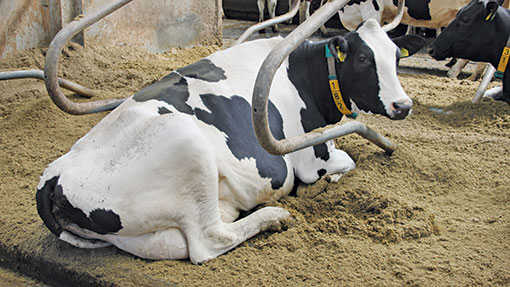Rules for using green bedding in dairy housing

New rules agreed by Defra, the Scottish government and industry stakeholders on the use of green bedding were published on the eve of the Livestock Event. Gemma Claxton reports.
Dairy farmers can continue to legally use recycled manure solids (RMS) as bedding in England and Scotland under strict conditions, but the position in Wales remains under review.
RMS or “green bedding” is made by separating water from manure or slurry to produce material with a minimum dry matter content of 34%.
This alternative source of bedding came to UK farmers’ attention last year, prompting DairyCo research into its benefits and risks. Initial studies showed RMS improved cow comfort, cleanliness and reduced costs.
See also Manure-into-bedding gains popularity in Europe
However, further research is needed to fill significant knowledge gaps, for which Defra has allowed two years.
The use of RMS bedding can still be stopped by Defra or the Scottish government at any point, should uncontrollable risks to public or animal health emerge.
AHVLA veterinary inspectors may also stop its use, or introduce further control measures on farms where risk of notifiable disease spread is considered unacceptable.
For these reasons, DairyCo has advised farmers to “act responsibly” in light of the opportunities and associated risks when adopting this technology.
Compulsory conditions for RMS bedding use
Dairy or beef farmers using or considering RMS bedding must follow these conditions:
- RMS must be produced only from cattle manure or slurry – no other species
- Do not use composted or digested material
- RMS must be produced from slurry on the unit where it will be used
- Slurry for RMS production cannot be moved to another unit
- Other than TB, farms under notifiable disease restrictions cannot produce RMS
- Slurry/manure from TB reactors and inconclusives cannot be used for RMS
- Slurry/manure from aborted cattle under brucellosis investigation cannot be used for RMS
- Other materials, such as birth fluids, waste milk and manure from calving areas, must not be included
- RMS and feed equipment must be kept separately
- Separators must be thoroughly cleaned and disinfected if moved to a different unit
- RMS must only be used with housed cattle more than six months old
- Milk from herds using RMS must be pasteurised
- Separators must produce minimum 34% dry matter manure solids
- RMS must only be used in cubicle housing.
What the experts say about green bedding
Dan Humphries, veterinary surgeon, XL Vets
A fair amount of data on RMS use as bedding is available from the USA and EU, but we don’t know yet how it adapts to the UK, or have the long-term evidence to properly advise.
In the USA it works – a hot, dry climate or a cold, dry climate works well, but it is affected by the higher atmospheric humidity in the UK.
Potential financial benefits are very good, but there are many considerations – for example, udder health and salmonella, however we haven’t seen any major outbreaks attributed to RMS.
But one farmer has struggled with udder health and to an extent this is backed up by higher somatic cell counts and the increase in clinical mastitis cases.
Farmers should thoroughly consider RMS and think hard before deciding whether to use it. Visit others using it, ask how it works and contact your vet before weighing up costs versus benefits.
Can you tolerate a slight increase in cell count if you’re making savings in bedding?
Tim Hamilton, director, Kitt Agri
Green bedding is not for everyone. It works for some, not others, and we don’t understand why.
Those testing the system on US dairy farms were one of the first to use it, but have now stopped.
It’s a high management input system and work in the USA has shown it is more effective on smaller farms with high attention to detail.
As a company we are not pushing green bedding, we’re promoting manure separation. Farmers considering it should justify the capital costs on manure separation grounds alone. If they then go down the green bedding route that’s fair enough, but there are still many unanswered questions.
Peter Shipton, senior technical manager, Kingshay
There is limited anecdotal evidence, but a farmer who’s used it for six months in cubicles as a deep bed and also as a mattress topper has had a mixed response.
The mattress topper was a success – the farmer saw improved hygiene, it aided cleaning the mattress and kept the cows physically clean without using too much bedding.
It was replaced twice a day so bacteria had little chance to multiply. Cow cleanliness was good and the incidence of clinical mastitis halved, although stomatic cell counts rose.
However, the farm also switched to three-times-a-day milking at the same time, so the reduction in mastitis can’t be solely attributed to the bedding.
The deep-bedded cubicles were a different story. The farmer found them difficult to manage and he was unsure whether to rake them; this caused the bed to heat up.
Another thing is it sounds like it’s a free bedding, but the separator and slurry pumps aren’t cheap and have to be factored in. It should be seen as an alternative; it’s very absorbent, but with a high replacement rate.
